Murdoch University BSL202: Employment Law Assignment Solution
VerifiedAdded on 2022/11/01
|9
|1960
|498
Homework Assignment
AI Summary
This assignment solution addresses two key issues in employment law. The first question examines the classification of an individual as either an employee or an independent contractor, analyzing the case of William, a delivery van driver, and applying legal principles from cases such as Kaseris v Rasier Pacific V.O.F and Hollis v Vabu Pty Ltd. The analysis considers factors like vehicle ownership, payment terms, and the presence of a 'work-wages bargain' to determine the employment relationship. The second question focuses on whether an employee, Sam, is eligible for payment after failing to follow instructions and being warned about non-compliance. The analysis references the Fair Work Act and the case of Martin v Donut King Chirnside Park T/A Hersing Pty Ltd, assessing the presence of warnings and the nature of the misconduct to determine the eligibility for payment. The solution follows the IRAC method, providing a structured approach to legal problem-solving and demonstrating an understanding of relevant legislation and case law.
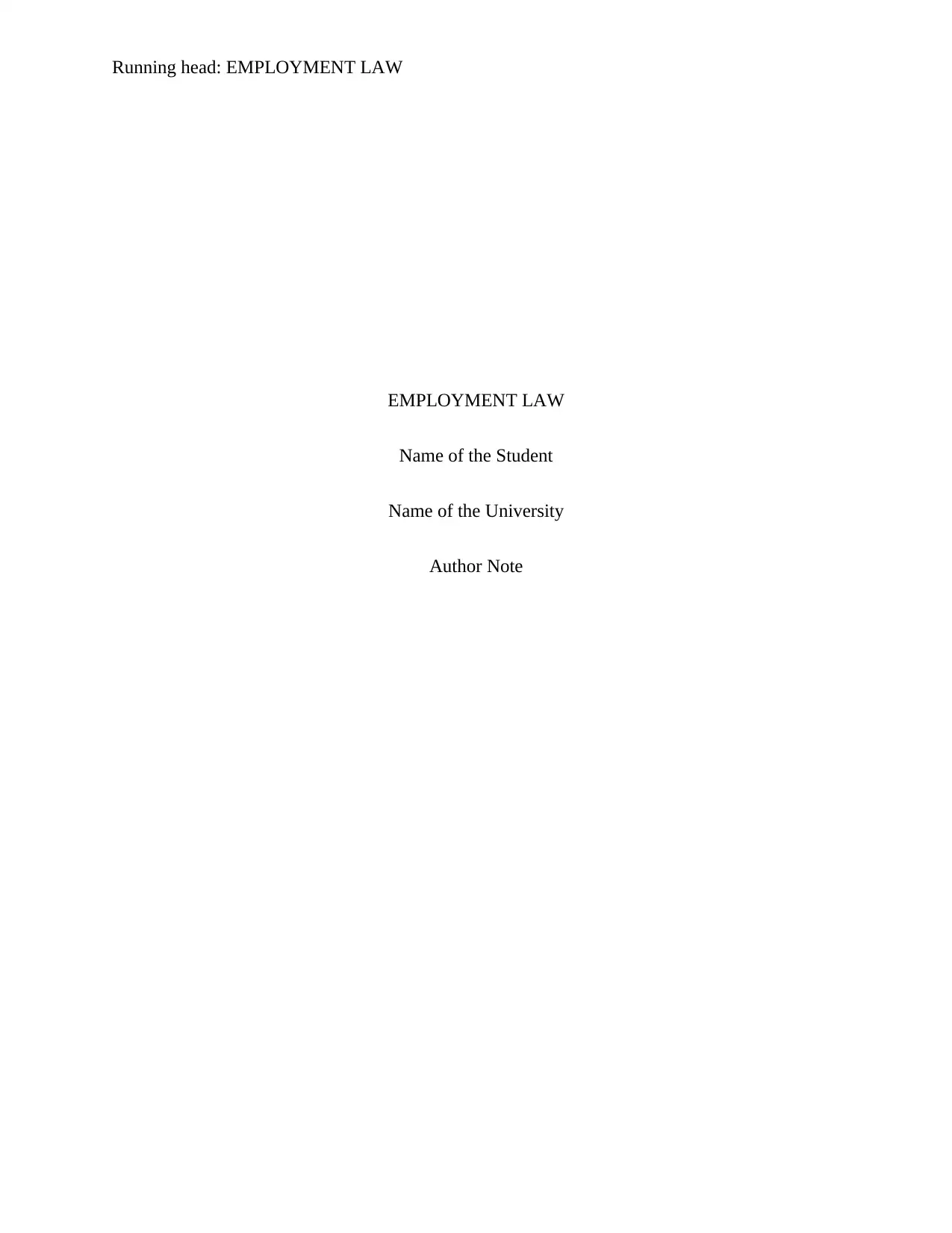
Running head: EMPLOYMENT LAW
EMPLOYMENT LAW
Name of the Student
Name of the University
Author Note
EMPLOYMENT LAW
Name of the Student
Name of the University
Author Note
Paraphrase This Document
Need a fresh take? Get an instant paraphrase of this document with our AI Paraphraser
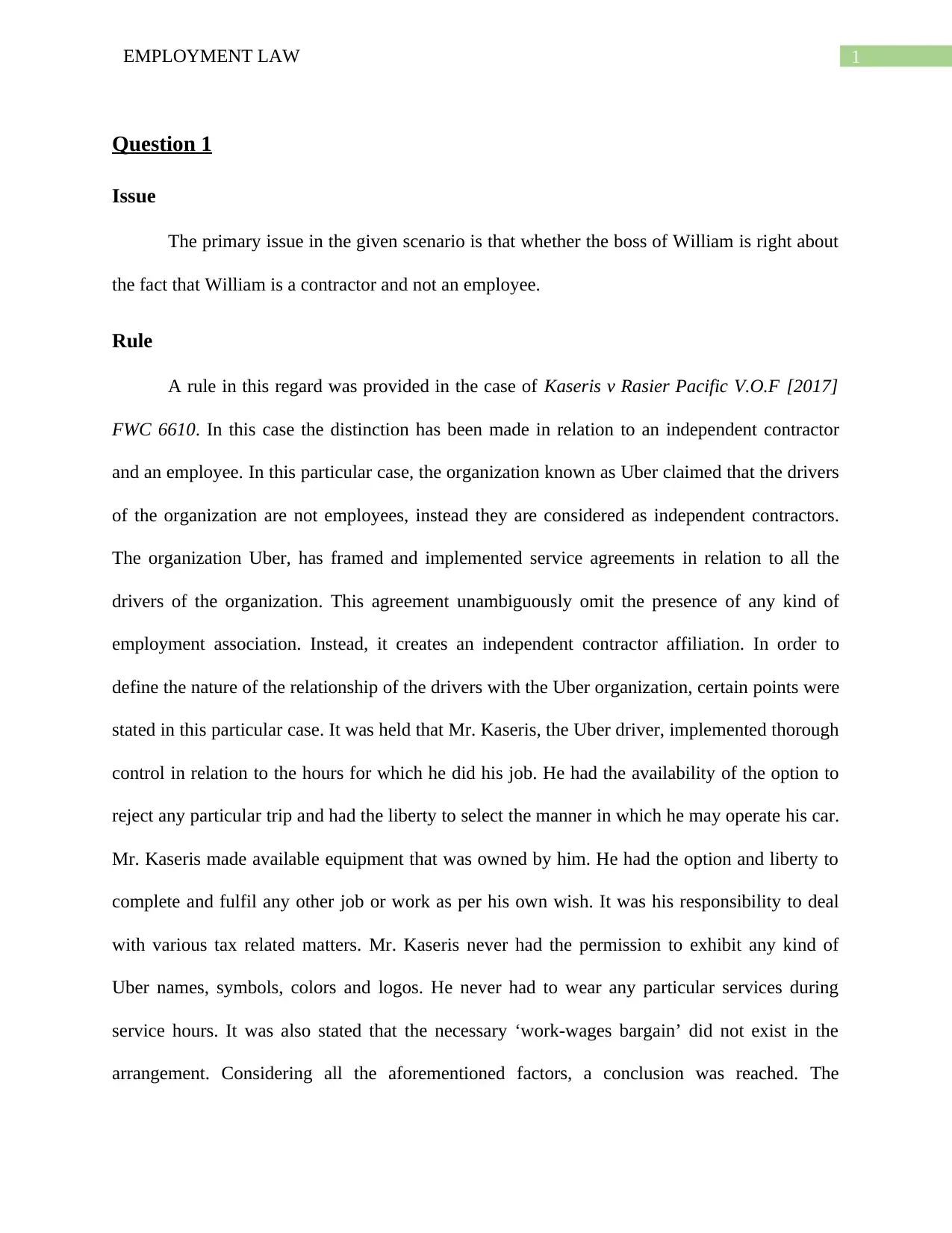
1EMPLOYMENT LAW
Question 1
Issue
The primary issue in the given scenario is that whether the boss of William is right about
the fact that William is a contractor and not an employee.
Rule
A rule in this regard was provided in the case of Kaseris v Rasier Pacific V.O.F [2017]
FWC 6610. In this case the distinction has been made in relation to an independent contractor
and an employee. In this particular case, the organization known as Uber claimed that the drivers
of the organization are not employees, instead they are considered as independent contractors.
The organization Uber, has framed and implemented service agreements in relation to all the
drivers of the organization. This agreement unambiguously omit the presence of any kind of
employment association. Instead, it creates an independent contractor affiliation. In order to
define the nature of the relationship of the drivers with the Uber organization, certain points were
stated in this particular case. It was held that Mr. Kaseris, the Uber driver, implemented thorough
control in relation to the hours for which he did his job. He had the availability of the option to
reject any particular trip and had the liberty to select the manner in which he may operate his car.
Mr. Kaseris made available equipment that was owned by him. He had the option and liberty to
complete and fulfil any other job or work as per his own wish. It was his responsibility to deal
with various tax related matters. Mr. Kaseris never had the permission to exhibit any kind of
Uber names, symbols, colors and logos. He never had to wear any particular services during
service hours. It was also stated that the necessary ‘work-wages bargain’ did not exist in the
arrangement. Considering all the aforementioned factors, a conclusion was reached. The
Question 1
Issue
The primary issue in the given scenario is that whether the boss of William is right about
the fact that William is a contractor and not an employee.
Rule
A rule in this regard was provided in the case of Kaseris v Rasier Pacific V.O.F [2017]
FWC 6610. In this case the distinction has been made in relation to an independent contractor
and an employee. In this particular case, the organization known as Uber claimed that the drivers
of the organization are not employees, instead they are considered as independent contractors.
The organization Uber, has framed and implemented service agreements in relation to all the
drivers of the organization. This agreement unambiguously omit the presence of any kind of
employment association. Instead, it creates an independent contractor affiliation. In order to
define the nature of the relationship of the drivers with the Uber organization, certain points were
stated in this particular case. It was held that Mr. Kaseris, the Uber driver, implemented thorough
control in relation to the hours for which he did his job. He had the availability of the option to
reject any particular trip and had the liberty to select the manner in which he may operate his car.
Mr. Kaseris made available equipment that was owned by him. He had the option and liberty to
complete and fulfil any other job or work as per his own wish. It was his responsibility to deal
with various tax related matters. Mr. Kaseris never had the permission to exhibit any kind of
Uber names, symbols, colors and logos. He never had to wear any particular services during
service hours. It was also stated that the necessary ‘work-wages bargain’ did not exist in the
arrangement. Considering all the aforementioned factors, a conclusion was reached. The
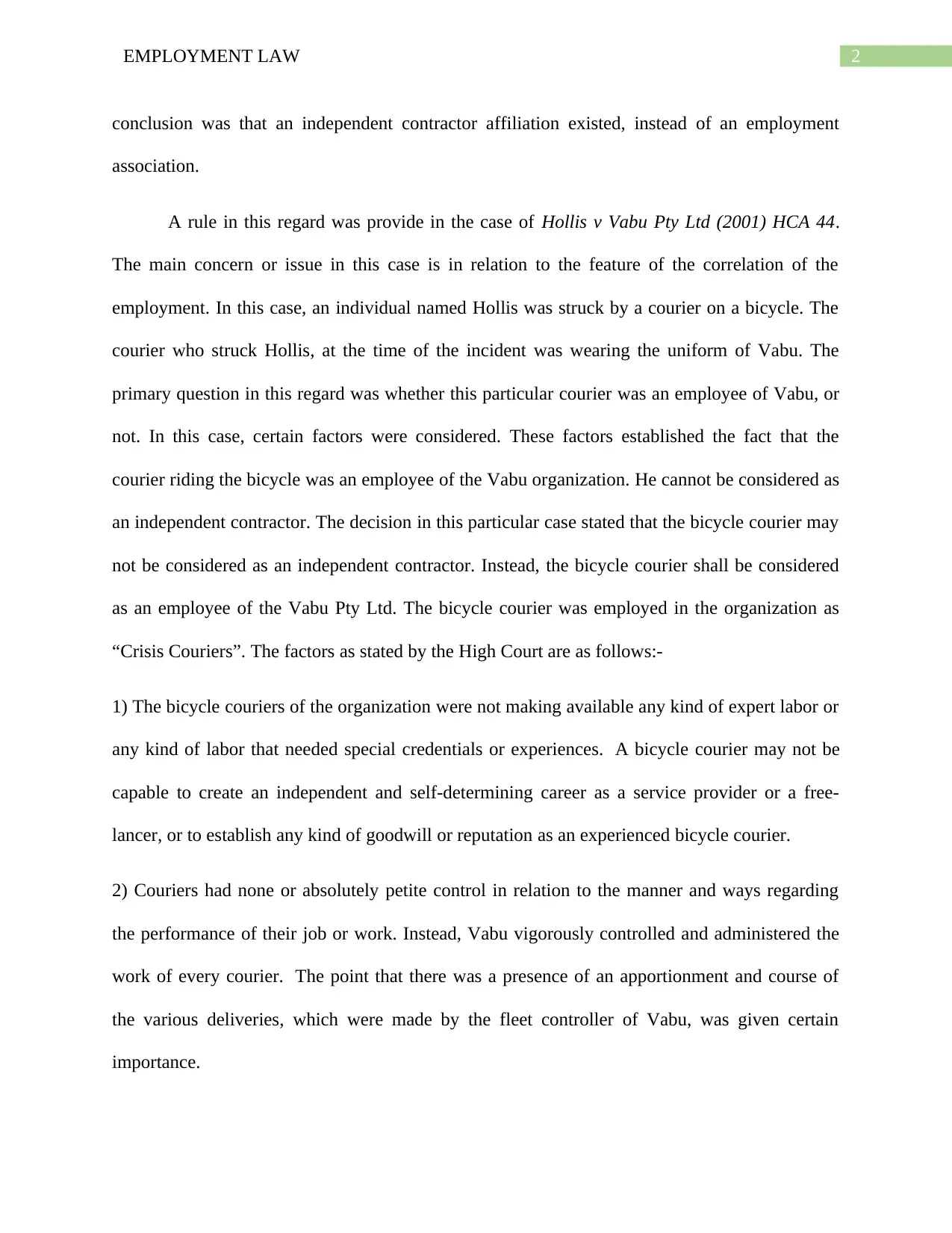
2EMPLOYMENT LAW
conclusion was that an independent contractor affiliation existed, instead of an employment
association.
A rule in this regard was provide in the case of Hollis v Vabu Pty Ltd (2001) HCA 44.
The main concern or issue in this case is in relation to the feature of the correlation of the
employment. In this case, an individual named Hollis was struck by a courier on a bicycle. The
courier who struck Hollis, at the time of the incident was wearing the uniform of Vabu. The
primary question in this regard was whether this particular courier was an employee of Vabu, or
not. In this case, certain factors were considered. These factors established the fact that the
courier riding the bicycle was an employee of the Vabu organization. He cannot be considered as
an independent contractor. The decision in this particular case stated that the bicycle courier may
not be considered as an independent contractor. Instead, the bicycle courier shall be considered
as an employee of the Vabu Pty Ltd. The bicycle courier was employed in the organization as
“Crisis Couriers”. The factors as stated by the High Court are as follows:-
1) The bicycle couriers of the organization were not making available any kind of expert labor or
any kind of labor that needed special credentials or experiences. A bicycle courier may not be
capable to create an independent and self-determining career as a service provider or a free-
lancer, or to establish any kind of goodwill or reputation as an experienced bicycle courier.
2) Couriers had none or absolutely petite control in relation to the manner and ways regarding
the performance of their job or work. Instead, Vabu vigorously controlled and administered the
work of every courier. The point that there was a presence of an apportionment and course of
the various deliveries, which were made by the fleet controller of Vabu, was given certain
importance.
conclusion was that an independent contractor affiliation existed, instead of an employment
association.
A rule in this regard was provide in the case of Hollis v Vabu Pty Ltd (2001) HCA 44.
The main concern or issue in this case is in relation to the feature of the correlation of the
employment. In this case, an individual named Hollis was struck by a courier on a bicycle. The
courier who struck Hollis, at the time of the incident was wearing the uniform of Vabu. The
primary question in this regard was whether this particular courier was an employee of Vabu, or
not. In this case, certain factors were considered. These factors established the fact that the
courier riding the bicycle was an employee of the Vabu organization. He cannot be considered as
an independent contractor. The decision in this particular case stated that the bicycle courier may
not be considered as an independent contractor. Instead, the bicycle courier shall be considered
as an employee of the Vabu Pty Ltd. The bicycle courier was employed in the organization as
“Crisis Couriers”. The factors as stated by the High Court are as follows:-
1) The bicycle couriers of the organization were not making available any kind of expert labor or
any kind of labor that needed special credentials or experiences. A bicycle courier may not be
capable to create an independent and self-determining career as a service provider or a free-
lancer, or to establish any kind of goodwill or reputation as an experienced bicycle courier.
2) Couriers had none or absolutely petite control in relation to the manner and ways regarding
the performance of their job or work. Instead, Vabu vigorously controlled and administered the
work of every courier. The point that there was a presence of an apportionment and course of
the various deliveries, which were made by the fleet controller of Vabu, was given certain
importance.
⊘ This is a preview!⊘
Do you want full access?
Subscribe today to unlock all pages.

Trusted by 1+ million students worldwide
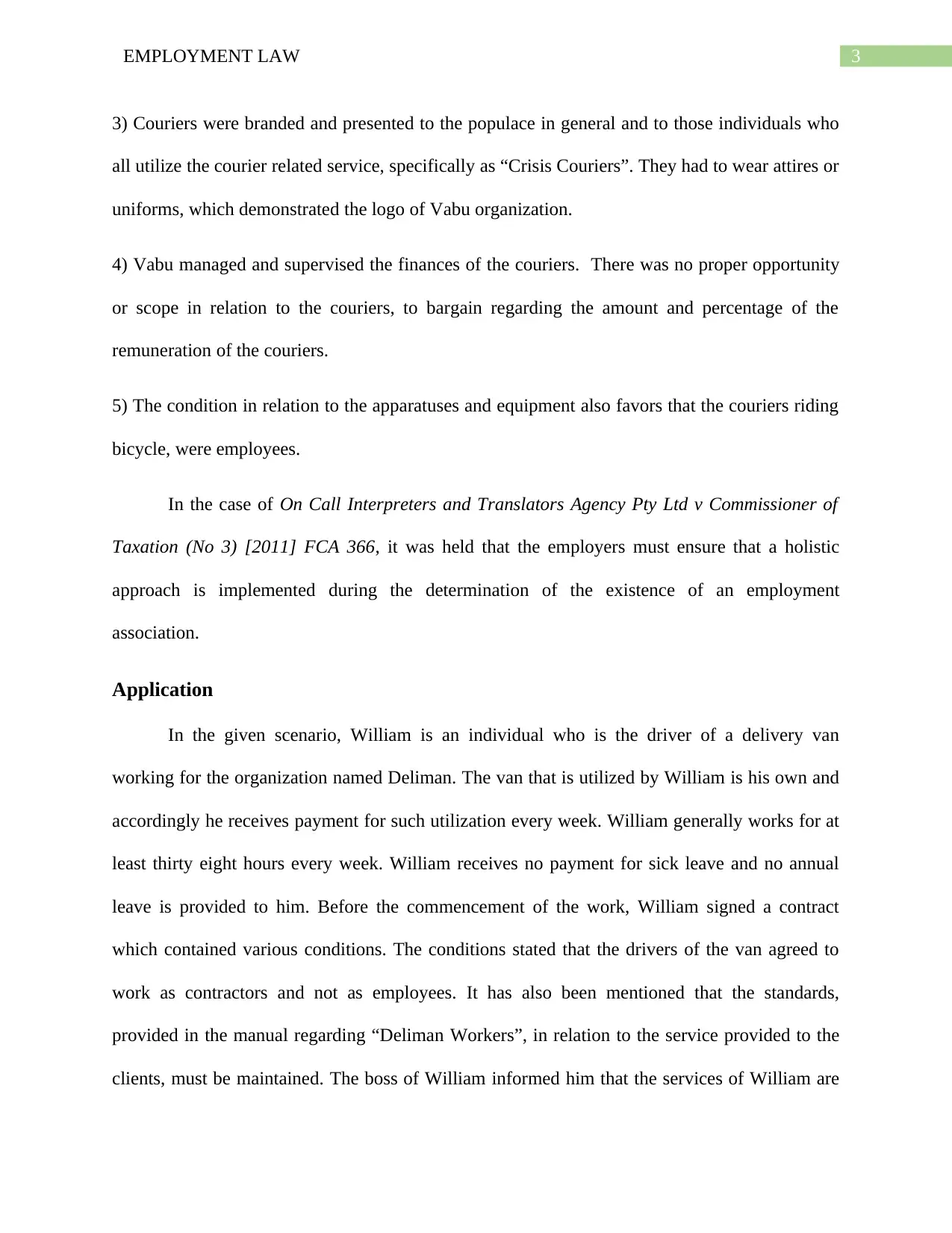
3EMPLOYMENT LAW
3) Couriers were branded and presented to the populace in general and to those individuals who
all utilize the courier related service, specifically as “Crisis Couriers”. They had to wear attires or
uniforms, which demonstrated the logo of Vabu organization.
4) Vabu managed and supervised the finances of the couriers. There was no proper opportunity
or scope in relation to the couriers, to bargain regarding the amount and percentage of the
remuneration of the couriers.
5) The condition in relation to the apparatuses and equipment also favors that the couriers riding
bicycle, were employees.
In the case of On Call Interpreters and Translators Agency Pty Ltd v Commissioner of
Taxation (No 3) [2011] FCA 366, it was held that the employers must ensure that a holistic
approach is implemented during the determination of the existence of an employment
association.
Application
In the given scenario, William is an individual who is the driver of a delivery van
working for the organization named Deliman. The van that is utilized by William is his own and
accordingly he receives payment for such utilization every week. William generally works for at
least thirty eight hours every week. William receives no payment for sick leave and no annual
leave is provided to him. Before the commencement of the work, William signed a contract
which contained various conditions. The conditions stated that the drivers of the van agreed to
work as contractors and not as employees. It has also been mentioned that the standards,
provided in the manual regarding “Deliman Workers”, in relation to the service provided to the
clients, must be maintained. The boss of William informed him that the services of William are
3) Couriers were branded and presented to the populace in general and to those individuals who
all utilize the courier related service, specifically as “Crisis Couriers”. They had to wear attires or
uniforms, which demonstrated the logo of Vabu organization.
4) Vabu managed and supervised the finances of the couriers. There was no proper opportunity
or scope in relation to the couriers, to bargain regarding the amount and percentage of the
remuneration of the couriers.
5) The condition in relation to the apparatuses and equipment also favors that the couriers riding
bicycle, were employees.
In the case of On Call Interpreters and Translators Agency Pty Ltd v Commissioner of
Taxation (No 3) [2011] FCA 366, it was held that the employers must ensure that a holistic
approach is implemented during the determination of the existence of an employment
association.
Application
In the given scenario, William is an individual who is the driver of a delivery van
working for the organization named Deliman. The van that is utilized by William is his own and
accordingly he receives payment for such utilization every week. William generally works for at
least thirty eight hours every week. William receives no payment for sick leave and no annual
leave is provided to him. Before the commencement of the work, William signed a contract
which contained various conditions. The conditions stated that the drivers of the van agreed to
work as contractors and not as employees. It has also been mentioned that the standards,
provided in the manual regarding “Deliman Workers”, in relation to the service provided to the
clients, must be maintained. The boss of William informed him that the services of William are
Paraphrase This Document
Need a fresh take? Get an instant paraphrase of this document with our AI Paraphraser
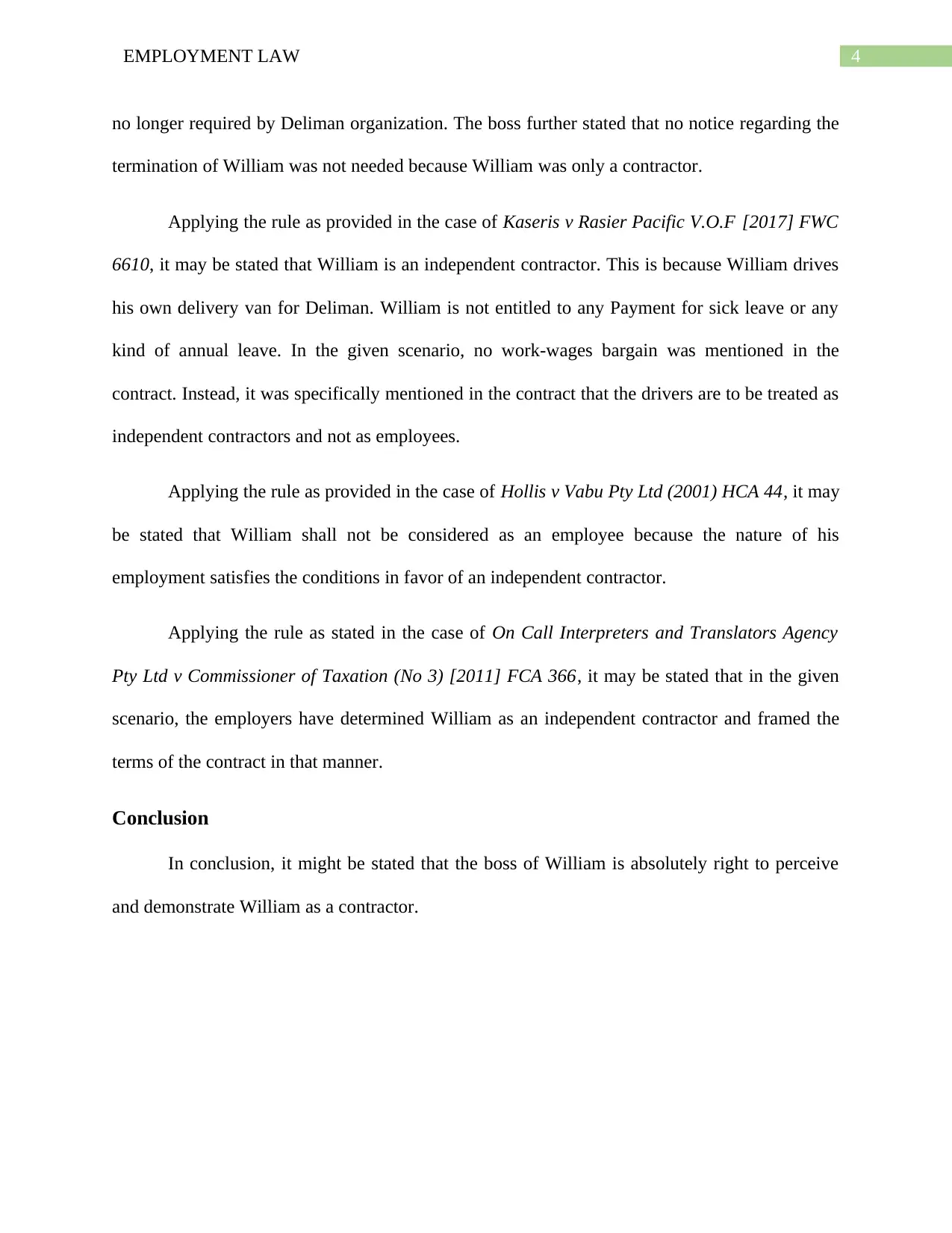
4EMPLOYMENT LAW
no longer required by Deliman organization. The boss further stated that no notice regarding the
termination of William was not needed because William was only a contractor.
Applying the rule as provided in the case of Kaseris v Rasier Pacific V.O.F [2017] FWC
6610, it may be stated that William is an independent contractor. This is because William drives
his own delivery van for Deliman. William is not entitled to any Payment for sick leave or any
kind of annual leave. In the given scenario, no work-wages bargain was mentioned in the
contract. Instead, it was specifically mentioned in the contract that the drivers are to be treated as
independent contractors and not as employees.
Applying the rule as provided in the case of Hollis v Vabu Pty Ltd (2001) HCA 44, it may
be stated that William shall not be considered as an employee because the nature of his
employment satisfies the conditions in favor of an independent contractor.
Applying the rule as stated in the case of On Call Interpreters and Translators Agency
Pty Ltd v Commissioner of Taxation (No 3) [2011] FCA 366, it may be stated that in the given
scenario, the employers have determined William as an independent contractor and framed the
terms of the contract in that manner.
Conclusion
In conclusion, it might be stated that the boss of William is absolutely right to perceive
and demonstrate William as a contractor.
no longer required by Deliman organization. The boss further stated that no notice regarding the
termination of William was not needed because William was only a contractor.
Applying the rule as provided in the case of Kaseris v Rasier Pacific V.O.F [2017] FWC
6610, it may be stated that William is an independent contractor. This is because William drives
his own delivery van for Deliman. William is not entitled to any Payment for sick leave or any
kind of annual leave. In the given scenario, no work-wages bargain was mentioned in the
contract. Instead, it was specifically mentioned in the contract that the drivers are to be treated as
independent contractors and not as employees.
Applying the rule as provided in the case of Hollis v Vabu Pty Ltd (2001) HCA 44, it may
be stated that William shall not be considered as an employee because the nature of his
employment satisfies the conditions in favor of an independent contractor.
Applying the rule as stated in the case of On Call Interpreters and Translators Agency
Pty Ltd v Commissioner of Taxation (No 3) [2011] FCA 366, it may be stated that in the given
scenario, the employers have determined William as an independent contractor and framed the
terms of the contract in that manner.
Conclusion
In conclusion, it might be stated that the boss of William is absolutely right to perceive
and demonstrate William as a contractor.
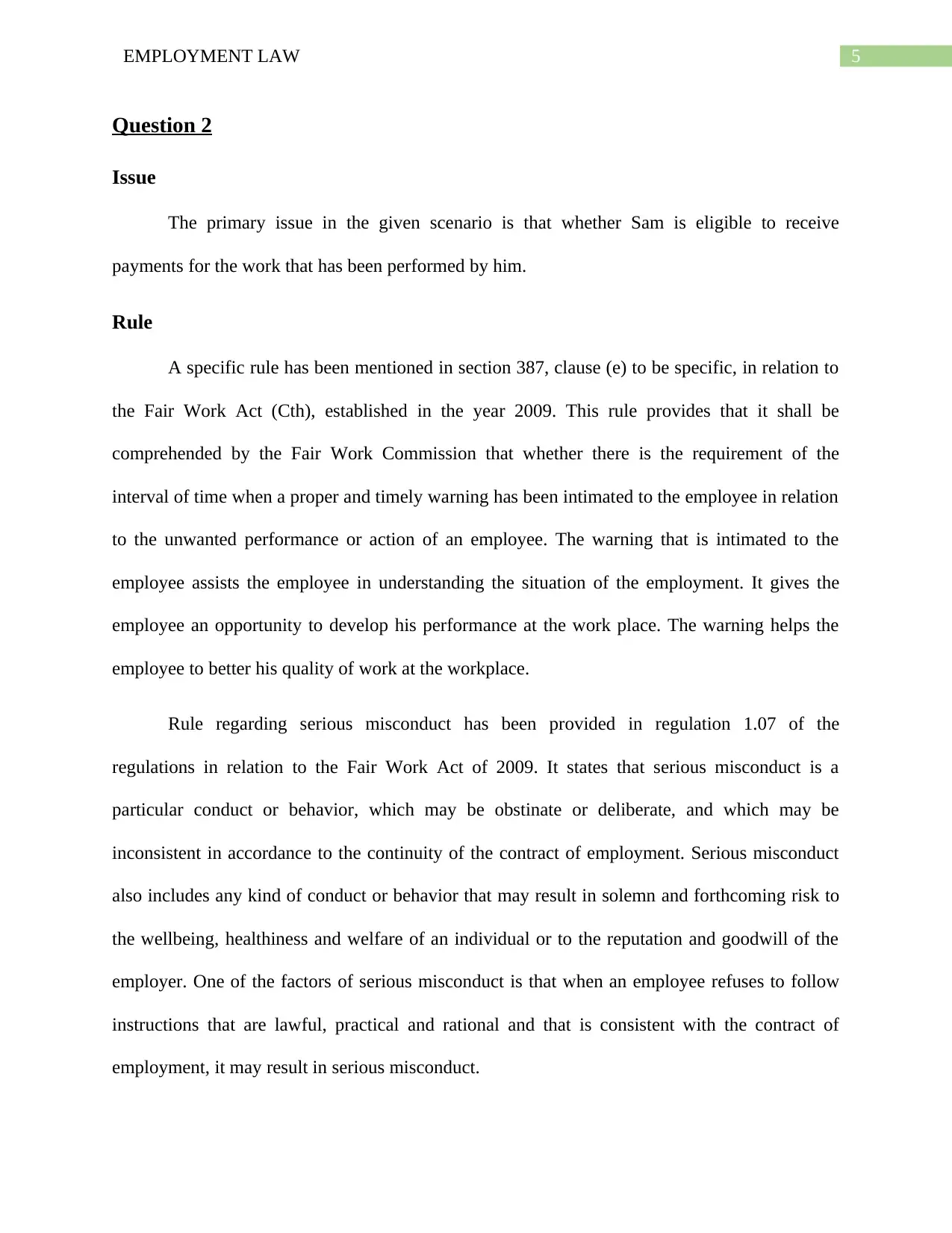
5EMPLOYMENT LAW
Question 2
Issue
The primary issue in the given scenario is that whether Sam is eligible to receive
payments for the work that has been performed by him.
Rule
A specific rule has been mentioned in section 387, clause (e) to be specific, in relation to
the Fair Work Act (Cth), established in the year 2009. This rule provides that it shall be
comprehended by the Fair Work Commission that whether there is the requirement of the
interval of time when a proper and timely warning has been intimated to the employee in relation
to the unwanted performance or action of an employee. The warning that is intimated to the
employee assists the employee in understanding the situation of the employment. It gives the
employee an opportunity to develop his performance at the work place. The warning helps the
employee to better his quality of work at the workplace.
Rule regarding serious misconduct has been provided in regulation 1.07 of the
regulations in relation to the Fair Work Act of 2009. It states that serious misconduct is a
particular conduct or behavior, which may be obstinate or deliberate, and which may be
inconsistent in accordance to the continuity of the contract of employment. Serious misconduct
also includes any kind of conduct or behavior that may result in solemn and forthcoming risk to
the wellbeing, healthiness and welfare of an individual or to the reputation and goodwill of the
employer. One of the factors of serious misconduct is that when an employee refuses to follow
instructions that are lawful, practical and rational and that is consistent with the contract of
employment, it may result in serious misconduct.
Question 2
Issue
The primary issue in the given scenario is that whether Sam is eligible to receive
payments for the work that has been performed by him.
Rule
A specific rule has been mentioned in section 387, clause (e) to be specific, in relation to
the Fair Work Act (Cth), established in the year 2009. This rule provides that it shall be
comprehended by the Fair Work Commission that whether there is the requirement of the
interval of time when a proper and timely warning has been intimated to the employee in relation
to the unwanted performance or action of an employee. The warning that is intimated to the
employee assists the employee in understanding the situation of the employment. It gives the
employee an opportunity to develop his performance at the work place. The warning helps the
employee to better his quality of work at the workplace.
Rule regarding serious misconduct has been provided in regulation 1.07 of the
regulations in relation to the Fair Work Act of 2009. It states that serious misconduct is a
particular conduct or behavior, which may be obstinate or deliberate, and which may be
inconsistent in accordance to the continuity of the contract of employment. Serious misconduct
also includes any kind of conduct or behavior that may result in solemn and forthcoming risk to
the wellbeing, healthiness and welfare of an individual or to the reputation and goodwill of the
employer. One of the factors of serious misconduct is that when an employee refuses to follow
instructions that are lawful, practical and rational and that is consistent with the contract of
employment, it may result in serious misconduct.
⊘ This is a preview!⊘
Do you want full access?
Subscribe today to unlock all pages.

Trusted by 1+ million students worldwide
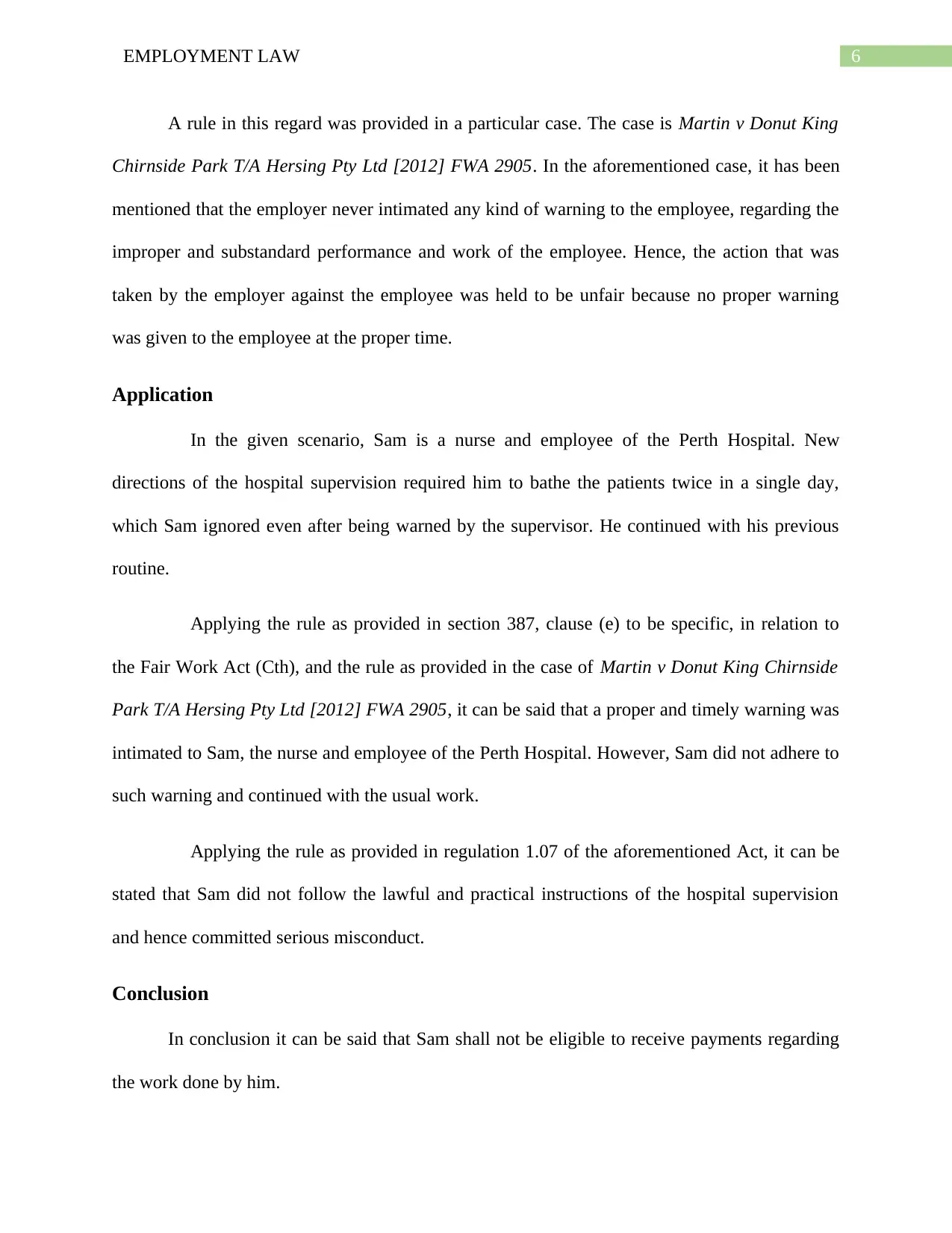
6EMPLOYMENT LAW
A rule in this regard was provided in a particular case. The case is Martin v Donut King
Chirnside Park T/A Hersing Pty Ltd [2012] FWA 2905. In the aforementioned case, it has been
mentioned that the employer never intimated any kind of warning to the employee, regarding the
improper and substandard performance and work of the employee. Hence, the action that was
taken by the employer against the employee was held to be unfair because no proper warning
was given to the employee at the proper time.
Application
In the given scenario, Sam is a nurse and employee of the Perth Hospital. New
directions of the hospital supervision required him to bathe the patients twice in a single day,
which Sam ignored even after being warned by the supervisor. He continued with his previous
routine.
Applying the rule as provided in section 387, clause (e) to be specific, in relation to
the Fair Work Act (Cth), and the rule as provided in the case of Martin v Donut King Chirnside
Park T/A Hersing Pty Ltd [2012] FWA 2905, it can be said that a proper and timely warning was
intimated to Sam, the nurse and employee of the Perth Hospital. However, Sam did not adhere to
such warning and continued with the usual work.
Applying the rule as provided in regulation 1.07 of the aforementioned Act, it can be
stated that Sam did not follow the lawful and practical instructions of the hospital supervision
and hence committed serious misconduct.
Conclusion
In conclusion it can be said that Sam shall not be eligible to receive payments regarding
the work done by him.
A rule in this regard was provided in a particular case. The case is Martin v Donut King
Chirnside Park T/A Hersing Pty Ltd [2012] FWA 2905. In the aforementioned case, it has been
mentioned that the employer never intimated any kind of warning to the employee, regarding the
improper and substandard performance and work of the employee. Hence, the action that was
taken by the employer against the employee was held to be unfair because no proper warning
was given to the employee at the proper time.
Application
In the given scenario, Sam is a nurse and employee of the Perth Hospital. New
directions of the hospital supervision required him to bathe the patients twice in a single day,
which Sam ignored even after being warned by the supervisor. He continued with his previous
routine.
Applying the rule as provided in section 387, clause (e) to be specific, in relation to
the Fair Work Act (Cth), and the rule as provided in the case of Martin v Donut King Chirnside
Park T/A Hersing Pty Ltd [2012] FWA 2905, it can be said that a proper and timely warning was
intimated to Sam, the nurse and employee of the Perth Hospital. However, Sam did not adhere to
such warning and continued with the usual work.
Applying the rule as provided in regulation 1.07 of the aforementioned Act, it can be
stated that Sam did not follow the lawful and practical instructions of the hospital supervision
and hence committed serious misconduct.
Conclusion
In conclusion it can be said that Sam shall not be eligible to receive payments regarding
the work done by him.
Paraphrase This Document
Need a fresh take? Get an instant paraphrase of this document with our AI Paraphraser

7EMPLOYMENT LAW
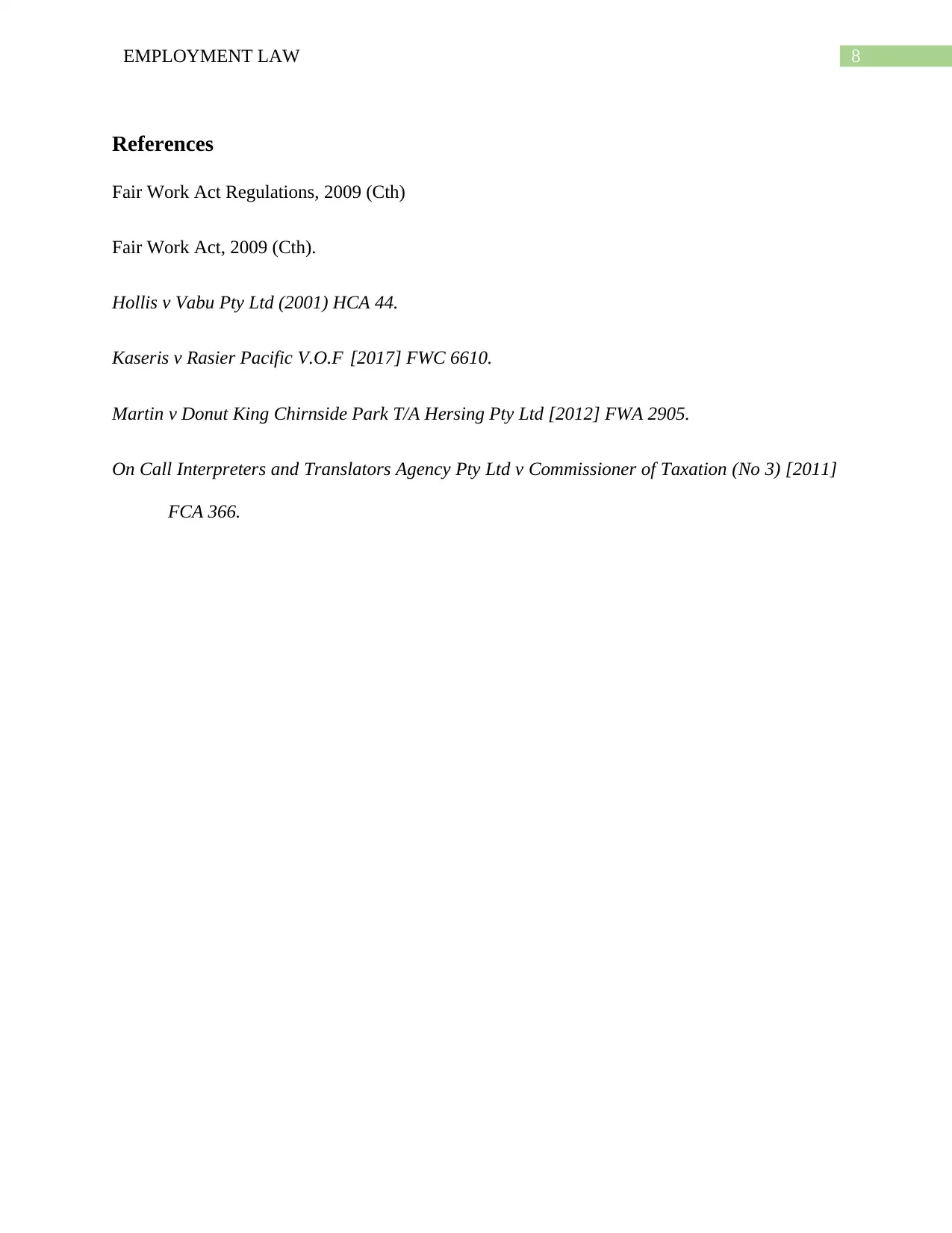
8EMPLOYMENT LAW
References
Fair Work Act Regulations, 2009 (Cth)
Fair Work Act, 2009 (Cth).
Hollis v Vabu Pty Ltd (2001) HCA 44.
Kaseris v Rasier Pacific V.O.F [2017] FWC 6610.
Martin v Donut King Chirnside Park T/A Hersing Pty Ltd [2012] FWA 2905.
On Call Interpreters and Translators Agency Pty Ltd v Commissioner of Taxation (No 3) [2011]
FCA 366.
References
Fair Work Act Regulations, 2009 (Cth)
Fair Work Act, 2009 (Cth).
Hollis v Vabu Pty Ltd (2001) HCA 44.
Kaseris v Rasier Pacific V.O.F [2017] FWC 6610.
Martin v Donut King Chirnside Park T/A Hersing Pty Ltd [2012] FWA 2905.
On Call Interpreters and Translators Agency Pty Ltd v Commissioner of Taxation (No 3) [2011]
FCA 366.
⊘ This is a preview!⊘
Do you want full access?
Subscribe today to unlock all pages.

Trusted by 1+ million students worldwide
1 out of 9
Related Documents
Your All-in-One AI-Powered Toolkit for Academic Success.
+13062052269
info@desklib.com
Available 24*7 on WhatsApp / Email
![[object Object]](/_next/static/media/star-bottom.7253800d.svg)
Unlock your academic potential
Copyright © 2020–2025 A2Z Services. All Rights Reserved. Developed and managed by ZUCOL.





